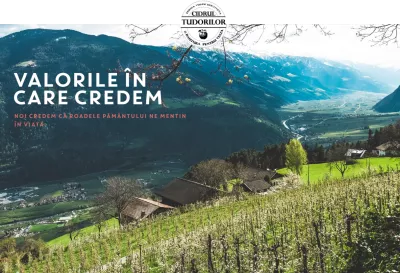General information
RDP Priority
- P5. Resource efficiency and climate
RDP Focus Area
- 5E: Carbon conservation & sequestration
RDP Measure
- M08: Investments in forest areas
Summary
The project is an afforestation initiative addressing soil erosion and soil degradation issues on the land of ‘Ferma Verde Din Bucovina’, a farm located in the Carpathian Mountains in Suceava County, Romania. CAP support has financed the plantation and continuing care of trees on an area of 3.88 hectares of land with the aim of achieving multiple environmental and climate change mitigation benefits. This has inspired the beneficiaries and provided them with the confidence and knowhow to become even more pro-active in rural development.
Results
The new afforestation area will have the following beneficial effects over the next 15-20 years:
- Converting farmland into productive economic use.
- Reducing risks from erosion, landslides, dust and water loss.
- Ecologically restoring the area, including the development of microflora and microfauna.
- Increasing the level of CO2 sequestration.
- Increasing the groundwater level.

Promoter
Ferma Verde din Bucovina srl
Funding
Total budget 44 435 (EUR)
EAFRD 37 770 (EUR)
National/Regional 6 665 (EUR)
Context
Situated in the Carpathian Mountains in Suceava County, Romania, the parish of Bunesti is known for its hilly territory, fruit growing and cattle breeding. Although Suceava County is the most forested area in Romania (49.7% of its territory is forest), Bunesti and its neighbouring communes are characterised by an almost total absence of any forest.
Alina and Eusebiu Tudor founded Ferma Verde Din Bucovina (the Green Farm from Bucovina) in 2015 on 20 hectares of land. It includes an organic apple orchard (7ha), an apple barn and a modern cidery to produce natural apple cider. In addition, the farm business operates a mountain cabin for tourists.
On certain plots of the farm that were used for sheep grazing, fragmented landslides were becoming an issue. Other land parcels were categorised as non-productive, degraded lands with a high degree of erosion (0.07 hectares), whilst other plots were categorised as seriously affected by landslides (1 hectare). Alina and Eusebiu applied for financial support from Romania’s Rural Development Programme (RDP) to rehabilitate this land into forest.
The financial support of the state aid scheme, granted as a fixed value, is represented by standard costs per hectare for the afforestation of agricultural and non-agricultural land.
Objectives
The main project purpose was to convert 3.88 hectares (approximately 10 football fields) of problematic farmland into forest to restore and improve the quality of soils.
Other objectives included: Improving localised air quality; Restoring hydrological balance; Ensuring permanence and stability of biodiversity; Combating climate change by reducing the effects of drought and limiting erosion and desertification; Soil protection and the progressive improvement of its production capacity under the direct effect of forest crops; Ensuring health standards of the population and the protection of human communities against harmful, natural and anthropogenic factors; as well as Improving the landscape aspect.
Activities
The main activities included:
Before submitting the grant application:
- Identifying the areas to be afforested, with the support of APIA (the Payments and Interventions Agency for Agriculture in Romania).
- Developing the project application addressing all technical requirements.
- Obtaining the approval of relevant authorities (Forest Guard) for the project.
Implementing the project:
- Implementing the afforestation works:
- Transporting the saplings from the nursery to the designated plot of land.
- Digging trenches for storing seedlings.
- Transporting the seedlings applying significant care by direct carrying.
- Enclosing the land for afforestation.
- Planting seedlings in pits.
- Cutting the stem of saplings in deciduous trees.
- Maintaining and caring for the planted seedlings and saplings, keeping the soil in a good state, loose and weed-free, supporting their growth and development etc. until the end of the grant agreement.
- Providing evidence of compliance with the conditions stipulated in the grant commitment.
Main results
The new afforestation area is expected to have the following beneficial environmental effects over the next 15-20 years:
- Stopping the erosion phenomena and implicitly stabilising landslides and deep erosion.
- Effective mitigation of large temperature fluctuations in the immediately neighbouring lands.
- Improving the retention of dust from the atmosphere (one hectare of forest retains approx. 30-35 tonnes/year/hectare of dust).
- Reducing wind speed across the land surface, which causes a decrease in the intensity of water evaporation from the soil.
- Ecologically restoring the area by producing plant material (fallen leaves) and intensifying the humification processes, involving the development of microflora and microfauna.
- Increasing the level of CO2 storage (sequestration) through the new woody mass and in the soil.
- Increasing the groundwater level.
- Sourcing of locally available wood products may ultimately also benefit the local population and shorten transport costs in future.
Key lessons and recommendations
- Inspired by the afforestation project, the farm owners are planning to plant more trees to further diversify into forest product development.
- Through their first experience of accessing EAFRD support, the farm owners learned about the importance of rural development. They felt inspired and supported in their entrepreneurial spirit and subsequently submitted a further, successful grant application for farm product development.
- The farm owners believe that their EAFRD project could be used as a good practice example to encourage other landowners to access existing financing opportunities and thereby contribute to a much-needed increase in forest land in the local area.
"The key to the efficient management of the forest is its continuous regeneration, both through natural regenerations, in which, in the first phase, nature is left to do its work, and then it is helped with a series of works absolutely necessary to obtain a quality stand, as well as through afforestation works, in which saplings that have already reached an advanced level of development are planted according to certain schemes that ensure the diversity and sustainable development of the future forest."
Sorin Ciobanu, head of the Suceava Forestry Directorate
